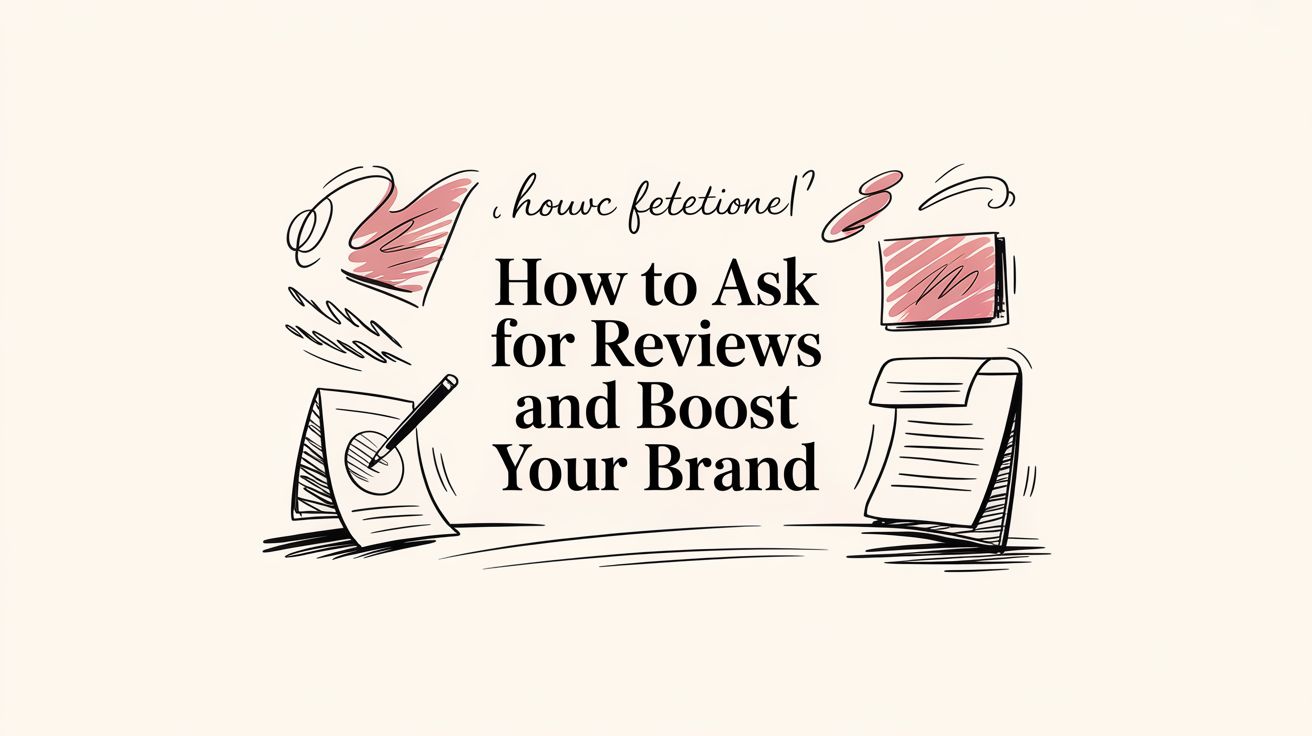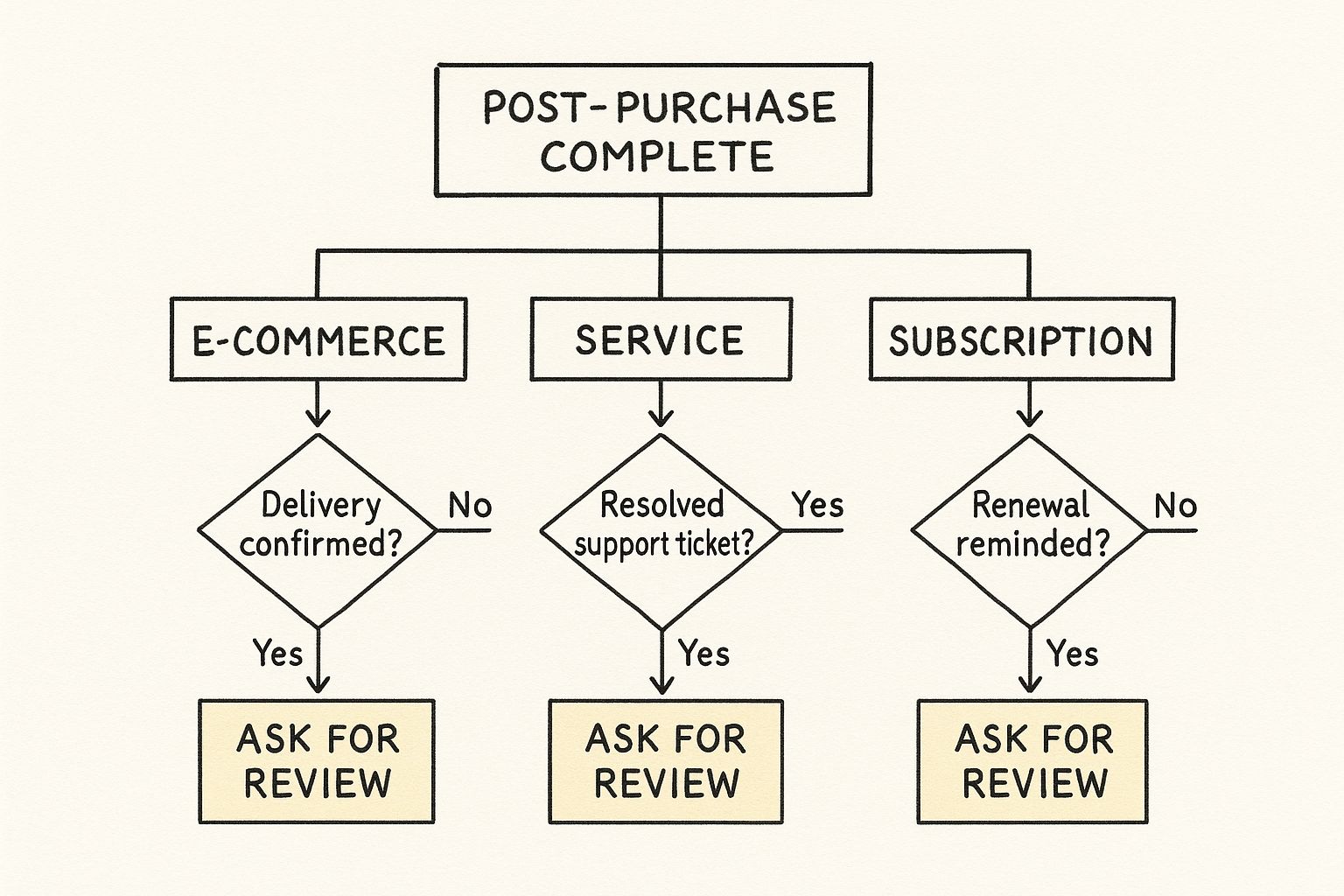How to Ask for Reviews and Boost Your Brand

Learning how to ask for reviews is actually pretty simple. It boils down to three things: make it personal, ask when your customer is happiest, and make the whole process ridiculously easy. Get this right, and you'll encourage happy customers to share their positive experiences without feeling like you're pressuring them.
Why Reviews Are Your Most Powerful Marketing Asset
Think of customer reviews as the modern-day version of a neighbour's trusted recommendation, only now it's amplified across the entire internet. They’re the social proof that signals to potential buyers that your business is trustworthy, reliable, and actually delivers on its promises. For a lot of businesses, a steady flow of genuine feedback isn't just a nice-to-have—it's the very foundation of their marketing.

This feedback loop does more than just pull in new customers; it actively shapes your brand's identity. Every single review contributes to the public story being told about your business, building a kind of reputation that you just can't buy with ads.
The Real Impact on Buyer Decisions
The influence of reviews on how people shop is undeniable, especially here in the UK. It’s not just about star ratings; it’s about the psychological trust they create. When a potential customer reads about someone else's great experience, they can start to picture their own success with your product or service.
The data backs this up completely. In the UK, online reviews have become a critical part of the buying journey, with over 90% of consumers relying on them to decide what to buy. A recent study found that 50% of UK shoppers check online reviews before buying from a new retailer—that’s nearly double the rate of those who check social media.
Even more telling? A massive 94% admit that negative reviews have directly stopped them from making a purchase. You can dive deeper into these UK online review statistics and what they mean for businesses.
This reliance on what others think highlights a massive shift. People trust other people far more than they'll ever trust a polished marketing message.
Today, your customers are your most effective marketers. Their authentic stories and genuine praise carry more weight than any perfectly crafted advertisement ever could.
Building a System for Consistent Feedback
Just waiting around and hoping for the occasional, unsolicited review to pop up is a risky game. To really tap into their power, you need a system for asking. This means creating a repeatable process that consistently brings in fresh, relevant feedback.
A structured system ensures you are:
- Capturing feedback at just the right moment, when customers are most satisfied.
- Making it dead simple for them to respond, removing any hassle from the process.
- Organising and showing off your best reviews to maximise their impact.
This is where a dedicated platform becomes essential. Trying to manually track and request feedback just doesn't scale as your business grows. Using a tool like GoodKudos turns this entire process into a reliable engine for building social proof, letting you automatically collect, manage, and display customer testimonials without the effort.
Finding the Perfect Moment to Ask for a Review
Knowing how to ask for a review is one thing, but knowing when is the secret ingredient. Timing really is everything.
Get it wrong, and your request feels intrusive or pushy. But get it right, and it feels like a natural, helpful part of the conversation. The trick is to identify what experts call ‘moments of delight’ in your customer's journey.
These are the peak points of satisfaction where your customer feels happiest with your product or service. This is when they’re most emotionally primed and willing to share their positive experience. For an e-commerce brand, this might be the moment a long-awaited package is confirmed as delivered. For a service business, it could be immediately after a support ticket is successfully resolved.
Identifying Your Golden Opportunities
Every business has unique triggers that signal customer happiness. Your goal is to pinpoint these moments in your own workflow so your requests feel perfectly timed, not like an afterthought. It's about aligning your ask with their success.
Think about these common scenarios:
- For a freelance web designer: The moment a client enthusiastically approves the final website design.
- For a local cafe: A few minutes after a customer has finished their meal and is visibly satisfied.
- For an online course creator: Right after a student completes a major milestone or the final module.
This infographic breaks down how these moments differ across various business models, helping you visualise the ideal touchpoints in your customer's journey.

As you can see, the trigger for the request is always tied directly to the customer receiving the core value they paid for. That’s when their positive feelings are at their strongest.
The Data Behind Timely Requests
This isn’t just theory; the data backs it up. Consumer behaviour studies in the UK show a massive shift in trust, with peer-generated online reviews now being the most trusted source of information.
These studies found that timely review requests—like those sent soon after a product delivery—line up with peak consumer engagement and lead to much higher response rates. In fact, businesses that timed their review invitations to within a week of purchase saw a remarkable 40-60% increase in submissions compared to less timely requests. You can dig deeper into what's driving UK consumer behaviour on Reputation.com.
Pinpointing these moments of delight and acting on them is the difference between a review request that gets ignored and one that earns a glowing five-star testimonial. Your customer's excitement is a fleeting resource—use it wisely.
Of course, manually tracking every single customer journey to catch these perfect moments is nearly impossible, especially as you scale. This is where automation becomes a game-changer.
A platform like GoodKudos can help you set up automated triggers based on these key events. By connecting your workflow, you can ensure a personalised review request is sent at the exact moment of peak happiness, every single time. You’ll never miss an opportunity to capture valuable feedback again. Learn more at https://goodkudos.com.
Crafting a Review Request That Actually Gets a Response
Let's be honest, a generic, robotic review request is one of the easiest things for a customer to ignore. To actually get a response, your message needs to feel personal and genuine—whether it's an email, a text, or even a quick chat in person.
The secret is to stop making it about you and start focusing on the value of their feedback.

Frame the ask in a way that makes them feel like a valued partner, not just a number on a spreadsheet. It’s about showing you genuinely care about their experience and want to learn from it.
Personalise Beyond the First Name
True personalisation goes way beyond just dropping in a {{first_name}} tag. It’s about referencing their specific journey with your business. That one small detail shows you remember them, and it instantly makes the request feel less like a mass email blast.
Think about it. Instead of a bland "Thanks for your business," what if you said something like this?
- For a photographer: "It was such a joy capturing your family's portraits at the park last week. The light was just perfect!"
- For an e-commerce store: "I hope you're loving the new handmade ceramic mug. I remember you mentioned it was a gift."
- For a consultant: "I was thrilled to see the positive initial results from the marketing strategy we implemented together."
This isn't complicated, but it completely changes the tone. You're building on the positive rapport you've already established, making them far more likely to want to help you out.
Make It Ridiculously Easy to Leave a Review
Friction is the enemy of reviews. The second a customer has to click through multiple pages, create an account, or hunt for the right button, you've lost them. Your job is to make the process completely effortless.
Your request should require the absolute minimum effort from your customer. Think one or two clicks, max. The easier you make it, the more likely they are to follow through.
This is where a direct link is non-negotiable. Don't just say, "Find us on Google." Send them a link that takes them straight to the page where they can start writing. With a platform like GoodKudos, this is sorted. You can send customers a single link where they can leave written or video feedback in seconds, with no downloads or sign-ups needed.
Choose the Right Channel for Your Audience
So, how should you send the request? It all comes down to where your customers are most comfortable. Email is a classic for a reason, but don’t write off the power of SMS for its immediacy and sky-high open rates.
A recent report from the Competition and Markets Authority (CMA) actually highlights how effective multi-channel strategies are, pointing out that clear calls to action via email, SMS, or apps right after a purchase work wonders. In fact, that same report found that businesses actively asking for reviews see, on average, a 30% higher net positive sentiment score. (You can dig into more stats over on this customer experience deep dive on startups.co.uk).
To help you decide, here’s a quick breakdown of the most common channels.
Choosing the Right Channel for Your Review Request
This table compares different communication channels, helping you choose the best approach for your business and customer base.
| Channel | Best For | Pros | Cons |
|---|---|---|---|
| Detailed, relationship-based interactions (e.g., B2B, service-based businesses). | More space for personalisation and storytelling. | Lower open rates; can get lost in a crowded inbox. | |
| SMS | Quick, transactional businesses (e.g., e-commerce, appointments, local services). | Extremely high open rates (often over 90%); immediate. | Less space for context; can feel intrusive if overused. |
| In-Person | Brick-and-mortar stores, client-facing services where you have direct interaction. | Highly personal and effective; builds strong rapport. | Not scalable; relies on staff remembering to ask. |
| QR Code | Physical products, packaging, or in-store signage. | Bridges the gap between offline and online; easy to use. | Requires customer to have their phone and take action. |
Ultimately, the best approach is to meet your customers where they already are. A younger, tech-savvy crowd might respond instantly to a quick text, while a long-term B2B client will probably expect a more considered email. Test a few channels and see what resonates most with your audience.
The Smart Way to Ask for Reviews: Automation
Right, let's stop for a second. If you're still manually emailing every single customer asking for a review, you're making life harder for yourself. It’s not just time-consuming; it's inconsistent. As your business scales, great customers and their stories will inevitably slip through the cracks.
The secret to building a powerful engine of social proof is to put your review collection on autopilot.
Think of it this way: an automated workflow sends a perfectly timed, personalised review request every single time, without you lifting a finger. What was once a repetitive, manual chore becomes a reliable source of high-quality reviews. It’s a system that builds your reputation while you get on with actually running your business.
Building Your Automated Sequence
Automation isn't about spamming your customers with generic email blasts. Far from it. The real goal is to replicate that perfect, personal ask—but at scale. A solid automation sequence has a few key parts that work together to make the whole process feel timely and, well, human.
Your entire workflow should kick off based on specific triggers—those little signals that tell you a customer is happy and ready to share their thoughts.
For instance, a sequence could start the moment:
- An e-commerce order is marked as "delivered" in your system.
- A client project is officially completed and signed off.
- A customer support ticket is closed with a positive resolution.
Once that trigger fires, the system sends out your carefully crafted request. But it doesn't stop there. A smart sequence also includes follow-ups. If a customer hasn't replied after a few days, a gentle, friendly reminder can pop into their inbox automatically. This one small step can massively increase your response rate without any extra effort on your part.
Here’s a glimpse of how a dedicated platform can help you manage and display all those testimonials you collect.
An interface like this centralises all your feedback, turning scattered reviews into a powerful, shareable asset you can use anywhere.
The Power of a Dedicated Platform
Trying to stitch together an automation system with a bunch of different tools is often clunky and just plain inefficient. This is where a dedicated testimonial platform becomes a real game-changer. A tool built specifically for this job handles every single step of the process in one place.
Using a dedicated platform isn't just about saving time; it's about creating a superior experience for your customers and a more powerful marketing asset for your business. It ensures every request is professional, on-brand, and incredibly easy for them to act on.
With a platform like GoodKudos, you can build these smart automation sequences in minutes. It lets you create a branded, frictionless experience where customers can leave written or video feedback without having to log in or download a thing.
All your reviews are then funnelled into a central "Kudos Wall" that you can embed directly on your website. Just like that, positive feedback becomes your most persuasive marketing tool.
Turning Feedback into Your Best Marketing Tool
Getting a steady stream of reviews is a massive win, but that's really just the starting line. The real magic happens when you stop seeing feedback as a simple rating and start treating it as your most powerful marketing asset. This is the shift from passively collecting reviews to actively using them to build your brand’s reputation from the ground up.

It's all about engaging with every piece of feedback you get, strategically repurposing your best testimonials, and making sure those success stories are front and centre at every stage of the buyer's journey.
Engage with Every Single Review
Responding to reviews—both the glowing ones and the critical ones—is completely non-negotiable. It shows you’re listening, you genuinely value what your customers have to say, and there’s a real, caring person behind the brand.
For positive reviews, a simple, personalised "thank you" can make a customer feel truly seen and appreciated, deepening their loyalty.
And negative feedback? While it can sting, it's actually a golden opportunity. A thoughtful, professional response that acknowledges the problem and offers a solution shows everyone watching that you’re committed to great service. It tells potential customers that even if things go wrong, you’re dedicated to making it right.
Repurpose Reviews into Social Proof
Your best reviews shouldn't just be left to gather dust on a single platform. Think of them as ready-made marketing content, waiting to be deployed across all your channels. By strategically showcasing your testimonials, you create powerful social proof that builds instant trust with people considering your brand.
Here are a few quick wins to get you started:
- Website Homepage: Add a rotating carousel with your top three reviews right on your homepage. It makes an immediate, powerful first impression.
- Product or Service Pages: Place relevant testimonials directly alongside the products they relate to. This helps tackle specific doubts a buyer might have at the point of decision.
- Social Media Posts: Design simple, branded graphics that pull out a killer quote from a review and share it on Instagram, Facebook, or LinkedIn.
- Email Signatures: Pop a short, punchy line from a recent five-star review into your email signature. It's consistent, low-effort marketing that works for you every single day.
When you weave customer feedback directly into your marketing, you let your happiest clients do the selling for you.
Your most compelling marketing messages won’t come from your team; they’ll come directly from the mouths of your satisfied customers. Turn their success stories into the foundation of your brand’s narrative.
Trying to manage all this manually can get chaotic, fast. The key is to centralise your feedback so it becomes a usable asset, not just a disorganised collection of comments. A platform like GoodKudos pulls all your feedback into a single, embeddable "Kudos Wall." This makes it incredibly easy to manage, respond to, and showcase your best reviews anywhere on your site, turning customer praise into a dynamic, brand-building tool.
Answering the Awkward Questions About Reviews
Right, you've got your review request strategy dialled in, but what about the curveballs? Even the best plans run into tricky situations. Knowing how to handle the awkward moments is just as important as knowing how to ask in the first place.
Let's unpack a couple of the most common questions that pop up.
What Should I Do About a Fake Review?
Finding a fake negative review is infuriating. The temptation is to fire back an angry reply, but that’s the worst thing you can do. The key is to stay calm and be strategic, not emotional.
First, take a breath and do a quick check. Does the reviewer's name or the details they've shared match anyone in your customer records? If you can't find a trace of them, you're likely dealing with a fake.
Your next move is to report it. Every major platform, from Google to Trustpilot, has a process for flagging feedback that breaks their rules, like spam or clear conflicts of interest. Get that process started.
While you're waiting for the platform to do its thing, it's a good idea to post a polite, professional public reply.
Remember, your response to a fake review isn't for the person who wrote it. It’s for every single potential customer who will read it later. A calm, measured reply shows you’re a reasonable business owner, and that builds trust.
Something simple and factual is all you need. Try this: "Thanks for your feedback. We’ve had a look through our records but can't seem to find a client matching your name or the experience you described. We take all feedback seriously and would be happy to learn more if you could contact us directly."
It shows you’re on the ball without getting into a slanging match or validating their bogus claim.
Is It Okay to Offer Incentives for Reviews?
Ah, the million-dollar question. The short answer is a firm "it depends," because this can be an ethical and legal minefield. Major players like Google and Yelp have strict policies against offering rewards in exchange for reviews. They see it as compromising the authenticity of the feedback.
But the rules aren't black and white everywhere. Some approaches are generally seen as more acceptable:
- Run a competition: You can enter everyone who leaves a review (good, bad, or ugly) into a prize draw. The incentive isn't guaranteed, and crucially, it doesn't depend on the review being positive.
- Offer a discount on a future purchase: This is a bit of a grey area but is often viewed more favourably. It encourages repeat business rather than directly "buying" a five-star rating.
The absolute golden rule is that you must never ask specifically for a positive review in exchange for something. Your request has to be for honest, impartial feedback. Transparency is everything here. If you are running some kind of incentive, it’s best practice to be open about it.
Before you even think about launching an incentive programme, do yourself a favour and double-check the specific terms of service for the review platforms you're using.
Ready to stop chasing reviews and start building a powerful wall of social proof automatically? GoodKudos makes it incredibly simple to collect, manage, and showcase customer testimonials. Turn your happy clients into your most effective marketing asset.
Start building trust today at https://goodkudos.com.
Article created using Outrank
